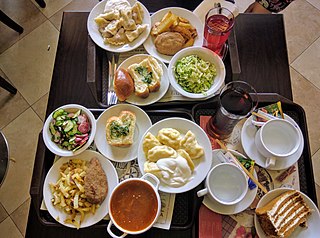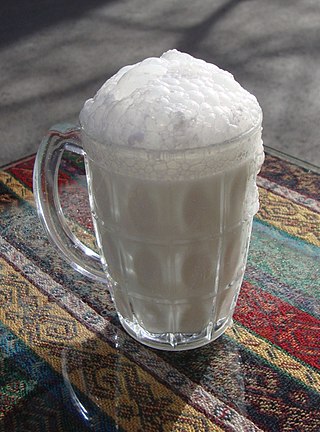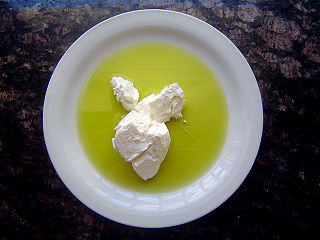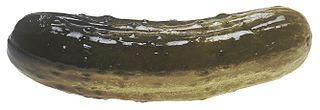
Yogurt is a food produced by bacterial fermentation of milk. Fermentation of sugars in the milk by these bacteria produces lactic acid, which acts on milk protein to give yogurt its texture and characteristic tart flavor. Cow's milk is most commonly used to make yogurt. Milk from water buffalo, goats, ewes, mares, camels, and yaks is also used to produce yogurt. The milk used may be homogenized or not. It may be pasteurized or raw. Each type of milk produces substantially different results.

Sauerkraut is finely cut raw cabbage that has been fermented by various lactic acid bacteria. It has a long shelf life and a distinctive sour flavor, both of which result from the lactic acid formed when the bacteria ferment the sugars in the cabbage leaves.

Lactic acid fermentation is a metabolic process by which glucose or other six-carbon sugars are converted into cellular energy and the metabolite lactate, which is lactic acid in solution. It is an anaerobic fermentation reaction that occurs in some bacteria and animal cells, such as muscle cells.

Ukrainian cuisine is the collection of the various cooking traditions of the people of Ukraine, one of the largest and most populous European countries. It is heavily influenced by the rich dark soil from which its ingredients come, and often involves many components. Traditional Ukrainian dishes often experience a complex heating process – "at first they are fried or boiled, and then stewed or baked. This is the most distinctive feature of Ukrainian cuisine".

Filmjölk, also known as fil, is a traditional fermented milk product from Sweden, and a common dairy product within most of the Nordic countries. It is made by fermenting cow's milk with a variety of bacteria from the species Lactococcus lactis and Leuconostoc mesenteroides. The bacteria metabolize lactose, the sugar naturally found in milk, into lactic acid, which means people who are lactose intolerant can tolerate it better than other dairy products. The acid gives filmjölk a sour taste and causes proteins in the milk, mainly casein, to coagulate, thus thickening the final product. The bacteria also produce a limited amount of diacetyl, a compound with a buttery flavor, which gives filmjölk its characteristic taste.

Skyr is a traditional Icelandic cultured dairy product. It has the consistency of strained yogurt, but a milder flavor. Skyr can be classified as a fresh sour milk cheese, similar to curd cheese consumed like a yogurt in the Baltic states, the Low Countries and Germany. It has been a part of Icelandic cuisine for centuries.

Viili (Finnish) is a mesophilic fermented milk product found in the Nordic countries, particularly Finland. Viili is similar to yoghurt or kefir, but when left unmixed, its texture is malleable, or "long". The metabolism of the bacteria used in the fermentation also gives viili a slightly different taste.
Norwegian cuisine in its traditional form is based largely on the raw materials readily available in Norway and its mountains, wilderness, and coast. It differs in many respects from continental cuisine through the stronger focus on game and fish. Many of the traditional dishes are the result of using conserved materials, necessary because of the long winters.

Ayran,dhallë, dew, Jaree'a, leben, avamast, çiqilmast, mastaw, shaneena, or xynogala is a cold savory yogurt-based beverage popular across Central Asia, West Asia, Southeastern Europe, South Asia, North Asia and Eastern Europe. The principal ingredients are yogurt, water and salt. Herbs such as mint may be optionally added. Some varieties are carbonated.

In food processing, fermentation is the conversion of carbohydrates to alcohol or organic acids using microorganisms—yeasts or bacteria—under anaerobic (oxygen-free) conditions. Fermentation usually implies that the action of microorganisms is desired. The science of fermentation is known as zymology or zymurgy.

Strained yogurt, Greek yogurt, yogurt cheese, sack yogurt or kerned yogurt is yogurt that has been strained to remove most of its whey, resulting in a thicker consistency than normal unstrained yogurt, while still preserving the distinctive sour taste of yogurt. Like many types, strained yogurt is often made from milk enriched by boiling off some water content, or by adding extra butterfat and powdered milk. In Europe and North America, it is often made from low-fat or fat-free cow's milk. In Iceland, a similar product named skyr is made.

Souring is a food preparation technique that causes a physical and chemical change in food by exposing it to an acid. This acid can be added explicitly, or can be produced within the food itself by a microbe, such as Lactobacillus.

A pickled cucumber – commonly known as a pickle in the United States and Canada and a gherkin in Britain, Ireland, South Africa, Australia, and New Zealand – is a usually small or miniature cucumber that has been pickled in a brine, vinegar, or other solution and left to ferment. The fermentation process is executed either by immersing the cucumbers in an acidic solution or through souring by lacto-fermentation. Pickled cucumbers are often part of mixed pickles.

Kefir is a fermented milk drink similar to a thin yogurt or ayran that is made from kefir grains, a specific type of mesophilic symbiotic culture. It is prepared by inoculating the milk of cows, goats, or sheep with kefir grains.

Ymer is a Danish soured milk product with 6 percent protein. Compared to standard yogurt, it has a thicker, creamier consistency and a higher protein content. It has a slightly buttery taste and may be very subtly fizzy due to slight carbonation from the lactic fermentation. It was launched commercially in the 1930s. It is made by fermenting whole milk with the bacterial culture Lactococcus lactis.

Laban rayeb is a type of curdled skim and fermented milk made in Lower Egypt. It may be drunk fresh or may be used to make areesh cheese, which in turn is used to make mish. There is evidence that it was made by the ancient Egyptians.

Pickled fruit refers to fruit that has been pickled. Pickling is the process of food preservation by either anaerobic fermentation in brine or immersion in vinegar. Many types of fruit are pickled. Some examples include peaches, apples, crabapples, pears, plums, grapes, currants, tomatoes and olives. Vinegar may also be prepared from fruit, such as apple cider vinegar.

Sour cream is a dairy product obtained by fermenting regular cream with certain kinds of lactic acid bacteria. The bacterial culture, which is introduced either deliberately or naturally, sours and thickens the cream. Its name comes from the production of lactic acid by bacterial fermentation, which is called souring. Crème fraîche is one type of sour cream with a high fat content and less sour taste.


















































































































































